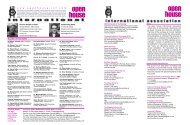Vol :37 Issue No.1 2012 - Open House International
Vol :37 Issue No.1 2012 - Open House International
Vol :37 Issue No.1 2012 - Open House International
Create successful ePaper yourself
Turn your PDF publications into a flip-book with our unique Google optimized e-Paper software.
Hilal Aycı & Esin Boyacıoğlu<br />
open house international <strong>Vol</strong>.<strong>37</strong> <strong>No.1</strong>, March <strong>2012</strong> A Reading in Critical Regionalism: Analysis Of Two <strong>House</strong>s By Han Tümertekin<br />
Figure 7. B2 <strong>House</strong> (photo by Cemal Emdem).<br />
Figure 8. SM <strong>House</strong> (photo by Cemal Emdem).<br />
rates and at the same time connects the guest room<br />
to the rest of the house (Fig. 5).<br />
Tactility<br />
“The space of dwelling is not a geometrical but an<br />
existential one, resulting from our phenomenological<br />
perception of place. Its construction is grounded<br />
in experience.” (De Sola-Morales, 1997: 47).<br />
Tümertekin himself declares his engagement<br />
with tactility through the usage of physical and<br />
perceptional elements of the site and local settlement.<br />
He also says that he is constantly concerned<br />
with topography, view, local materials, light, and<br />
climate, which are the realities of the site and rele-<br />
9 8<br />
vant to tactility (Tümertekin, 2008). By perceptional<br />
elements, Tümertekin means the architect’s sensivities<br />
as well as the client’s sensibility. From<br />
records of conversation between Tümertekin and<br />
the client of the SM <strong>House</strong>, we can understand that<br />
the client’s preference was to live in loft-like volumes<br />
of industrial buildings, appreciating their simplicity<br />
in construction and appearance. Thus, the<br />
industrial aesthetic had a direct influence on this<br />
project (Tümertekin, 2008). Tümertekin has translated<br />
the experiences the client wanted to bring in<br />
their life into a design such that the local villagers<br />
associated the building with an olive oil factory, the<br />
most familiar industrial building type in the area





